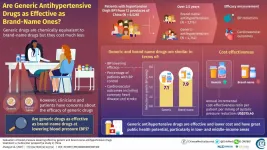Chronic exposure to low levels of blast may be associated with neurotrauma
Exposure during occupational training is linked to biomarkers of brain damage
2021-05-04
(Press-News.org) Scientists at the Walter Reed Army Institute for Research demonstrated that biomarkers associated with traumatic brain injury were elevated among law enforcement and military personnel, particularly in active duty participants with longer duration of service. Most notably, these elevated biomarker levels were observed in individuals without a diagnosed brain injury or concussion.
Some law enforcement and military personnel are regularly exposed to low levels of blast, particularly during training, due to the use of explosive charges and high caliber weapons. Understanding effects from these occupational exposures is a military health care priority to improve diagnosis and mitigation of ill effects.
While repeated exposure to low level blast is not known to result in clinically diagnosed traumatic brain injury, exposures have been linked to a series of reported symptoms such as headaches, fatigue, dizziness, memory difficulties, and tinnitus (ringing in the ears) -- collectively referred to as "breacher's brain" among members of affected communities.
This study, published in the Journal of the American Medical Association, measured neurotrauma biomarker concentrations in blood samples from 106 military and law enforcement personnel who were not actively engaged in training or physical activity at the time of blood collection and compared those concentrations with commercially available samples from individuals who were similar in sex and age but unlikely to have been exposed to blast.
"We found that five biomarkers previously associated with TBI and brain diseases were elevated among personnel when compared to controls," said Dr. Angela Boutte, lead author on the paper and a researcher at the WRAIR Brain Trauma Neuroprotection branch. "Given the difficulty of identifying and evaluating injury associated with repeated low level blast exposure, we hope these data are the first step in our collective goal to identify objective biomarkers as clinically relevant diagnostic tools."
Dr. Bharani Thangavelu and Dr. Walter Carr, WRAIR brain health researchers and co-authors, emphasized the potential impact of blast exposure experienced by military personnel stating, "Low level blast exposure in routine military training should not be expected to result in acute, gross behavioral deficits for the majority of personnel. However, repeated exposure across years does correlate with symptomology, especially when a history of chronic exposure is exacerbated by new, large magnitude exposures."
Efforts to identify and quantify the impact of blast and traumatic brain injury on Service Members have increased dramatically in recent years, including initiatives in response to Congressional mandates. Biomarkers of blast effects on brain health will be a useful tool in this effort, especially as tools that augment decision-making based on symptoms reported by personnel.
INFORMATION:
About the Walter Reed Army Institute of Research
Headquartered in Silver Spring, Maryland, the Walter Reed Army Institute of Research is the oldest and most mission-diverse biomedical research laboratory in the Department of Defense. WRAIR provides unique research capabilities and innovative solutions to a range of force health and readiness challenges currently facing U.S. Service Members, along with threats anticipated during future operations. With research units in the state of Washington, Africa, Asia and the Caucasus region, WRAIR houses three centers, the Center for Infectious Disease Research, the Center for Military Psychiatry and Neuroscience and the Center for Enabling Capabilities. For more information, visit https://www.wrair.army.mil.
The WRAIR Brain Trauma Neuroprotection and Blast Induced Neurotrauma Branches develop ground-breaking preventive, diagnostic, and therapeutic solutions to mitigate the effects of TBI at the point of injury to reduce morbidity and mortality.
ELSE PRESS RELEASES FROM THIS DATE:
2021-05-04
FAYETTEVILLE, Ark. - A new map including rover paths of the Schrodinger basin, a geologically important area of the moon, could guide future exploration missions.The map was created by a team of interns at the Lunar and Planetary Institute, including Ellen Czaplinski, a University of Arkansas graduate student researcher at the Arkansas Center for Planetary Sciences and first author of a paper published in The Planetary Science Journal.
The researchers identified significant geologic features of the Schrödinger basin, located near the lunar south ...
2021-05-04
Researchers at the U.S. Department of Energy's National Renewable Energy Laboratory (NREL) developed a breakthrough in energy-efficient phototransistors. Such devices could eventually help computers process visual information more like the human brain and be used as sensors in things like self-driving vehicles.
The structures rely on a new type of semiconductor--metal-halide perovskites--which have proven to be highly efficient at converting sunlight into electrical energy and shown tremendous promise in a range of other technologies.
"In general, these perovskite semiconductors are a really unique ...
2021-05-04
Hypertension is a common medical condition and a primary cause of cardiovascular diseases and stroke worldwide. Unfortunately, as Professor Wei-Li Zhang of the Chinese National Center for Cardiovascular Diseases notes, "the unaffordability of drugs is a major barrier to medication adherence among patients living in low- and middle-income areas."
One of the countries where hypertension is becoming a major problem is China where, researchers estimate, between 244 million and 300 million adults are living with hypertension. But true to Prof. Zhang's words, most cases of hypertension in China are not adequately ...
2021-05-04
With the explosion in digital entertainment options over the past several decades and the more recent restrictions on outdoor and in-person social activities, parents may worry that excessive engagement with digital technology could have long-term effects on their children's mental health.
A new study published in the journal Clinical Psychological Science, however, found little evidence for an increased association between adolescents' technology engagement and mental health problems over the past 30 years. The data did not consistently support the suggestion that the technologies we worry about most (e.g., smartphones) are becoming more ...
2021-05-04
DURHAM, N.C. - When patients complain of coughing, runny nose, sneezing and fever, doctors are often stumped because they have no fundamental tool to identify the source of the respiratory symptoms and guide appropriate treatments.
That tool might finally be on its way. In a study proving feasibility, researchers at Duke Health showed that their testing technology can accurately distinguish between a viral and a bacterial infection for respiratory illness - a critical difference that determines whether antibiotics are warranted. And, importantly, the test provided results in under an hour.
"This is exciting progress," said study lead Ephraim Tsalik, associate professor in the departments of Medicine ...
2021-05-04
A new study published in Medical Care Research and Review found that the Affordable Care Act, which expanded Medicaid programs to cover people previously uninsured, provided a financial boost to hospitals.
The study conducted by faculty at the Colorado School of Public Health on the University of Colorado Anschutz Medical Campus is the first to investigate the effects of Medicaid expansion by comparing estimates using data from both the Internal Revenue Service (IRS) and the Centers for Medicare and Medicaid Services (CMS).
"The IRS and CMS data sources serve as primary resources for assessing the impact of Medicaid expansion on hospitals' financial status. The comparison of the two is timely and can inform ...
2021-05-04
BOSTON - Researchers at Massachusetts General Hospital (MGH) have identified the protein "signature" of severe COVID-19, which they describe in a new study published in Cell Reports Medicine. "We were interested in asking whether we could identify mechanisms that might be contributing to death in COVID-19," says MGH infectious disease expert Marcia Goldberg, MD, who studies interactions between microbial pathogens and their hosts, and is senior author of the study. "In other words, why do some patients die from this disease, while others--who appear to be just as ill--survive?"
In March 2020, when the first patients with symptoms of COVID-19 ...
2021-05-04
Wherever scientists look, they can spot them: whether in remote mountain lakes, in Arctic sea ice, in the deep-ocean floor or in air samples, even in edible fish - thousands upon thousands of microscopic plastic particles in the micro to millimeter range. This microplastic is now even considered one of the defining features of the Anthropocene, the age of the Earth shaped by modern humans.
Microplastics are formed by weathering and physicochemical or biological degradation processes from macroscopic plastic products, such as the tons of plastic waste in the oceans. It is unlikely that these degradation processes will stop at the micrometer ...
2021-05-04
On September 28, 2018, an inexplicably large tsunami devastated the Indonesian coastal city of Palu and several others nearby. Between the tsunami and the magnitude 7.5 earthquake that caused it, some 4,340 people were killed, making it the deadliest earthquake that year.
The tsunami's waves reached around six meters high, which was a shock to geophysicists who had believed that earthquakes along a strike-slip fault could only trigger far smaller tsunamis for that particular region. Now, new research describes a mechanism for these large tsunamis to form, and suggests that other coastal cities that were thought to be safe from massive tsunamis may need to reevaluate their level of ...
2021-05-04
Daegu Gyeongbuk Institute of Science and Technology (DGIST) scientists in Korea have developed algorithms that more efficiently measure how difficult it would be for an attacker to guess secret keys for cryptographic systems. The approach they used was described in the journal IEEE Transactions on Information Forensics and Security and could reduce the computational complexity needed to validate encryption security.
"Random numbers are essential for generating cryptographic information," explains DGIST computer scientist Yongjune Kim, who co-authored the study with Cyril Guyot and Young-Sik Kim. "This randomness is crucial for the security of cryptographic systems."
Cryptography is ...
LAST 30 PRESS RELEASES:
[Press-News.org] Chronic exposure to low levels of blast may be associated with neurotrauma
Exposure during occupational training is linked to biomarkers of brain damage



